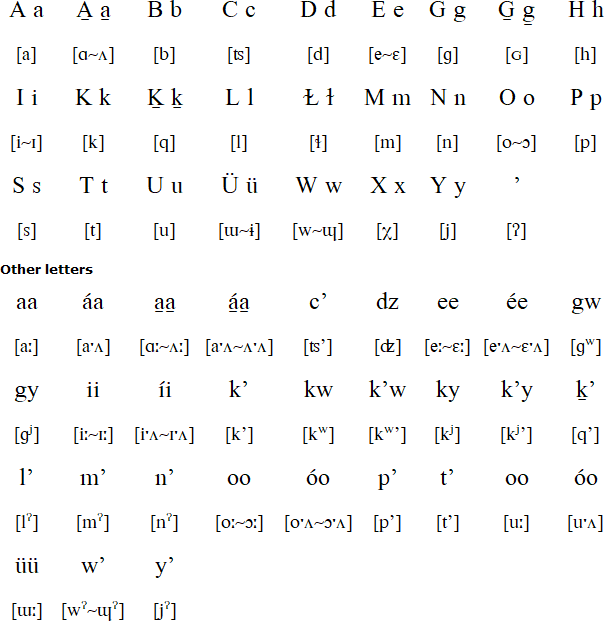Tsimshian is a Tsimshianic language spoken along the lower Skeena River in northwestern British Columbia in Canada, and at Metlakatla on Annette Island in southeastern Alaska in the USA.
The 2006 Canadian census counted 640 Tsimshian speakers, and there are thought to be 70 Tsimshian speakers in Alaska. Other sources estimate the number of Tsimshian speakers in Canada to be between 200 and 430 [Source 1, Source 2].
There are two main dialects of Tsimshian: Coastal and Southern. The former is spoken in Alaska, and the former in British Columbia. The majority of Tsimshian speakers are over 70, and few are under 50 years old.
Tsimshian is taught at the University of Alaska Southeast at Juneau.
The Tsimshian orthography used in Canada was developed in the 1960s by scholars working on Tsimshian, and related languages such as Gitksan and Nisga'a. It was substantially revised in the 1990s when textbooks for schools were being prepared. The Tsimshian Sm’algya̲x Authority currently oversees the language. A different orthography is used in Alaska, taught by the Dum Baal-dum organisation. In that orthography, the native name of the language is written Shm'algyack. This means 'real or true language'. The English name of the language is also written Zimshian.
Parts of the Book of Common Prayer were translated into Tsimshian by William Ridley and Jane Holmes Ridley and published in 1882.

Download an alphabet chart for Tsimshian (Excel)
Details of the Tsimshian alphabet provided by Wolfram Siegel
Source: Sm'algyax Living Legacy Talking Dictionary
Nagwādum gu zim lakāga n’lthōduksha na wānt. Am dum goiduksha na kingdom gunt. Shagaud-gun dum wāl halizokum nīwālda zim lakāga. Ginamlth a gum a sha gwa ām da shkabū wunēumt. Ada ma shalthīl na hadadakumi nīwālda dup wila shalthīl na hadak ga dī da gum. Ada gilau ma za dadēunt gum shpugait gun shpālt gaudit. Ada ma al dīlamaud gum a hadak gut. Awul nūngun nha wāl da da kingdom, dilth gutgiatit, dilth n’lthaumsh gut: ada dum lthā wila wāl dit. Amen.
Note: the spelling system used for this sample text is different to the alphabet above.
Source: A Zimshian Version of Portions of the Book of Common Prayer (1882)
Information about Tsimshian | Phrases | Numbers
Information about Tsimshian
https://en.wikipedia.org/wiki/Coast_Tsimshian_dialect
http://www.ethnologue.com/18/language/tsi
http://www.native-languages.org/tsimshian.htm
http://www.alaskool.org/language/Shimalgyack/default.htm
http://www.languagegeek.com/tsimshian/smalgyax.html
http://www.alaskanativelanguages.org/tsimshian
http://www.sorosoro.org/en/tsimshian-languages/
https://www.uaf.edu/anlc/languages/ts/
http://www.seattleglobalist.com/2015/12/08/smalgyax-native-american-language-preservation/44225
Sm’algya̲x Living Legacy Talking Dictionary
http://smalgyax.unbc.ca/
Languages written with the Latin alphabet
Page last modified: 26.04.21
[top]
You can support this site by Buying Me A Coffee, and if you like what you see on this page, you can use the buttons below to share it with people you know.

If you like this site and find it useful, you can support it by making a donation via PayPal or Patreon, or by contributing in other ways. Omniglot is how I make my living.
Note: all links on this site to Amazon.com, Amazon.co.uk
and Amazon.fr
are affiliate links. This means I earn a commission if you click on any of them and buy something. So by clicking on these links you can help to support this site.
[top]